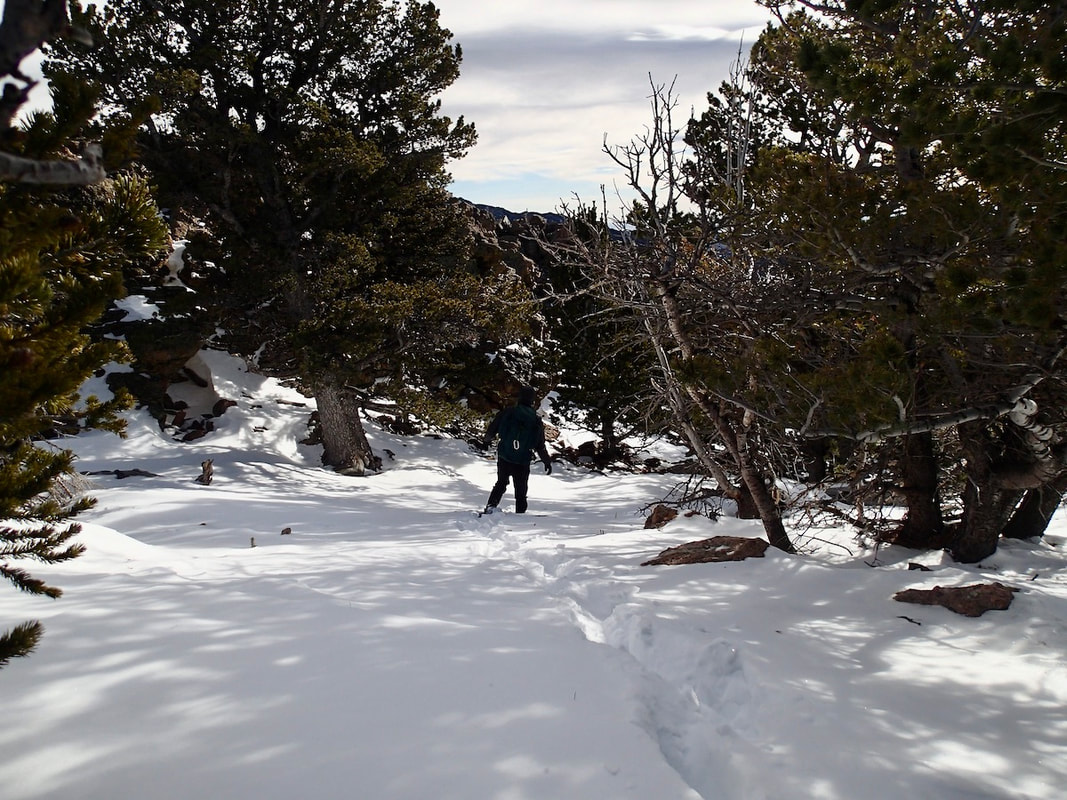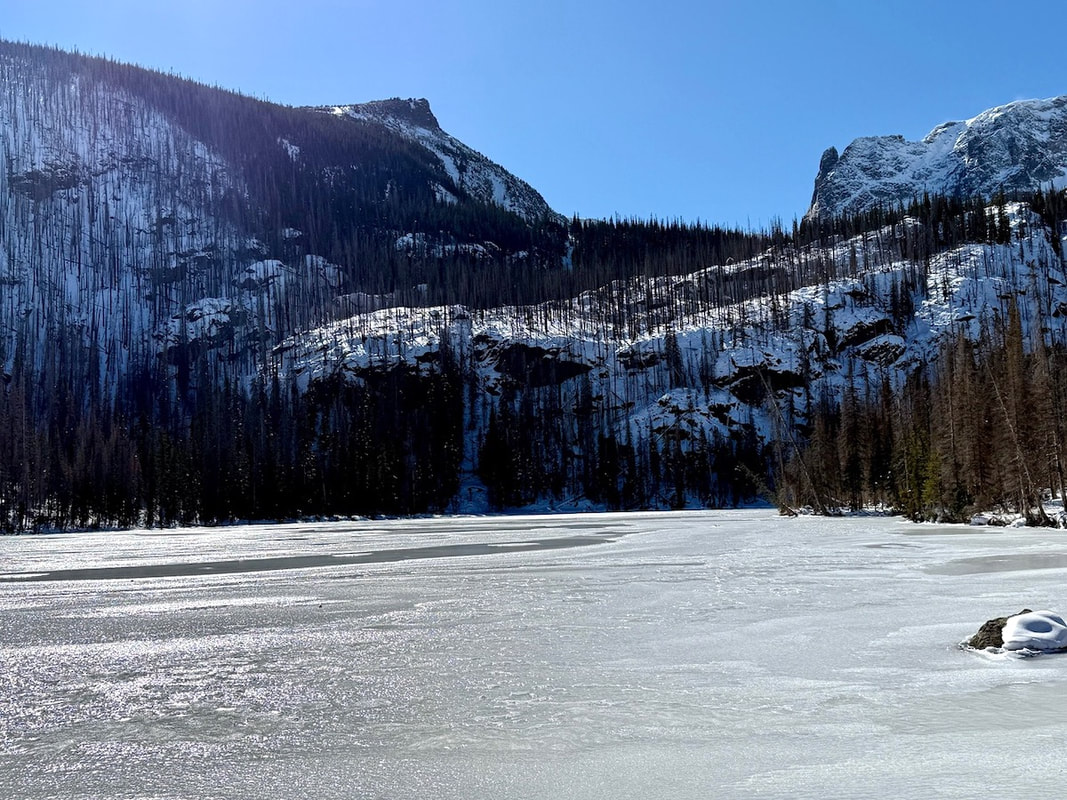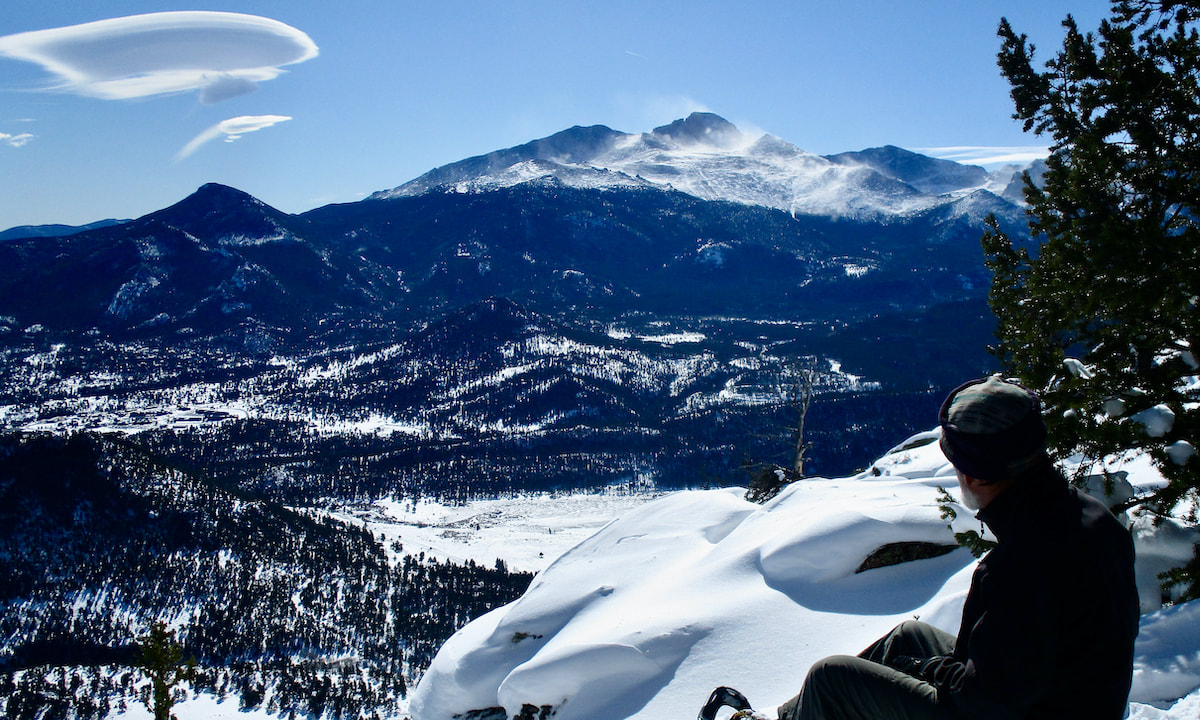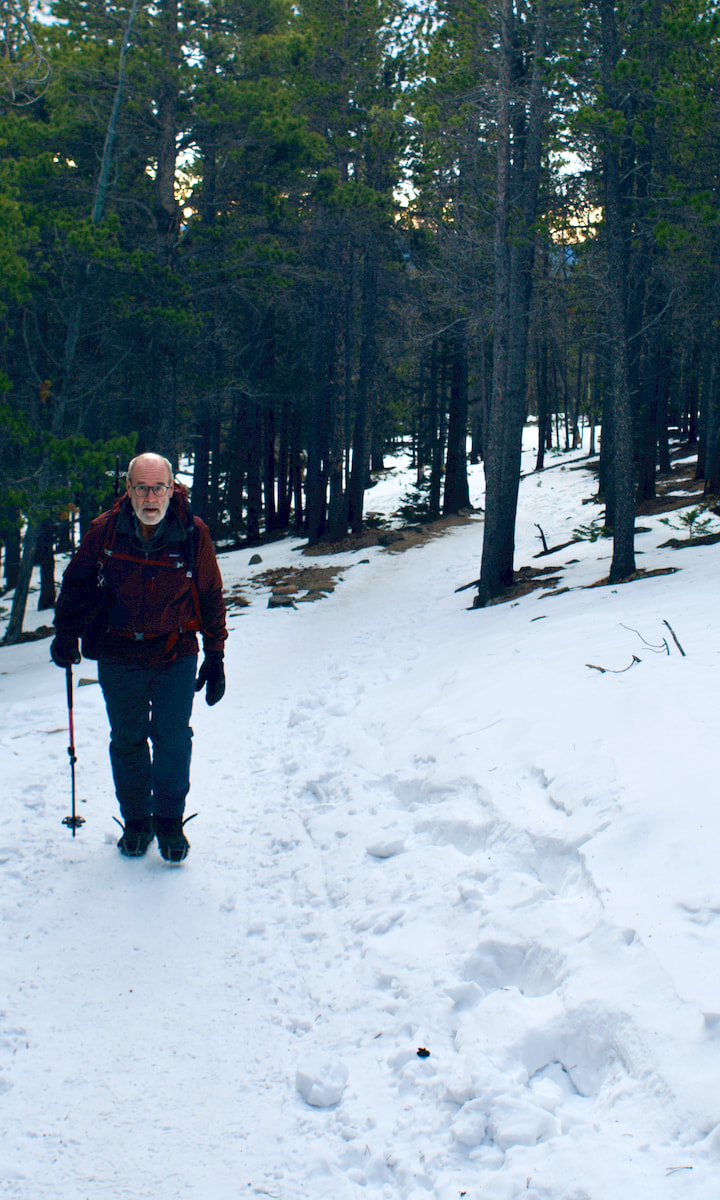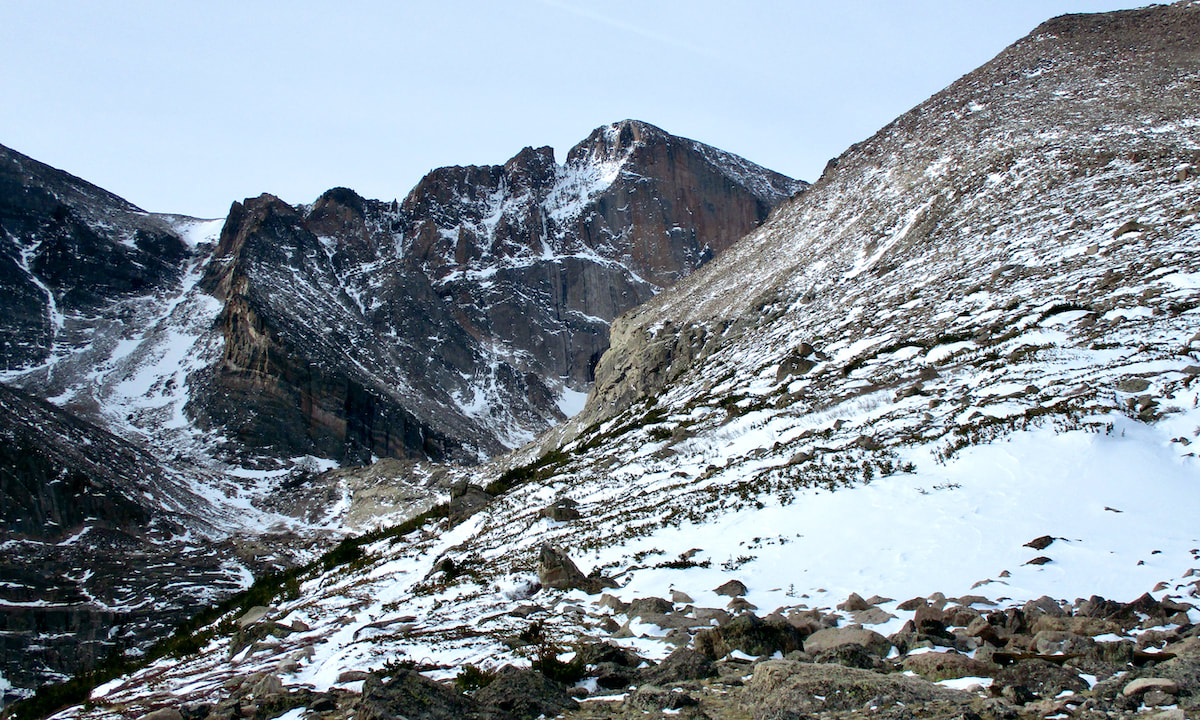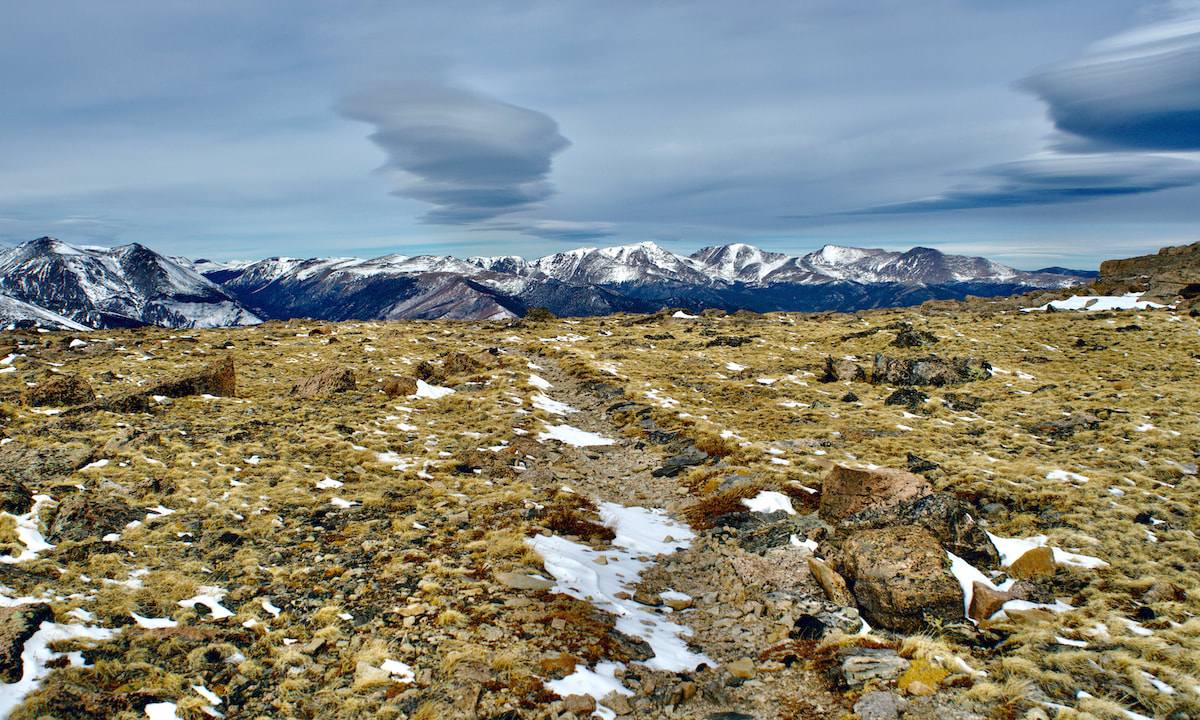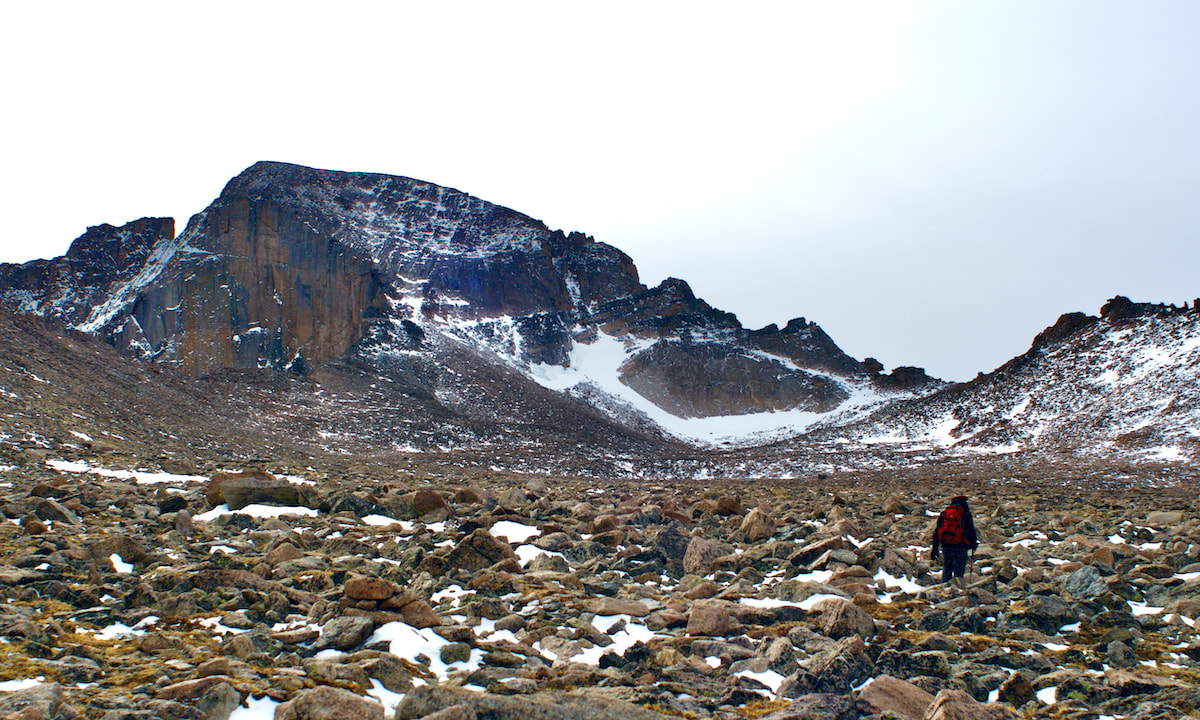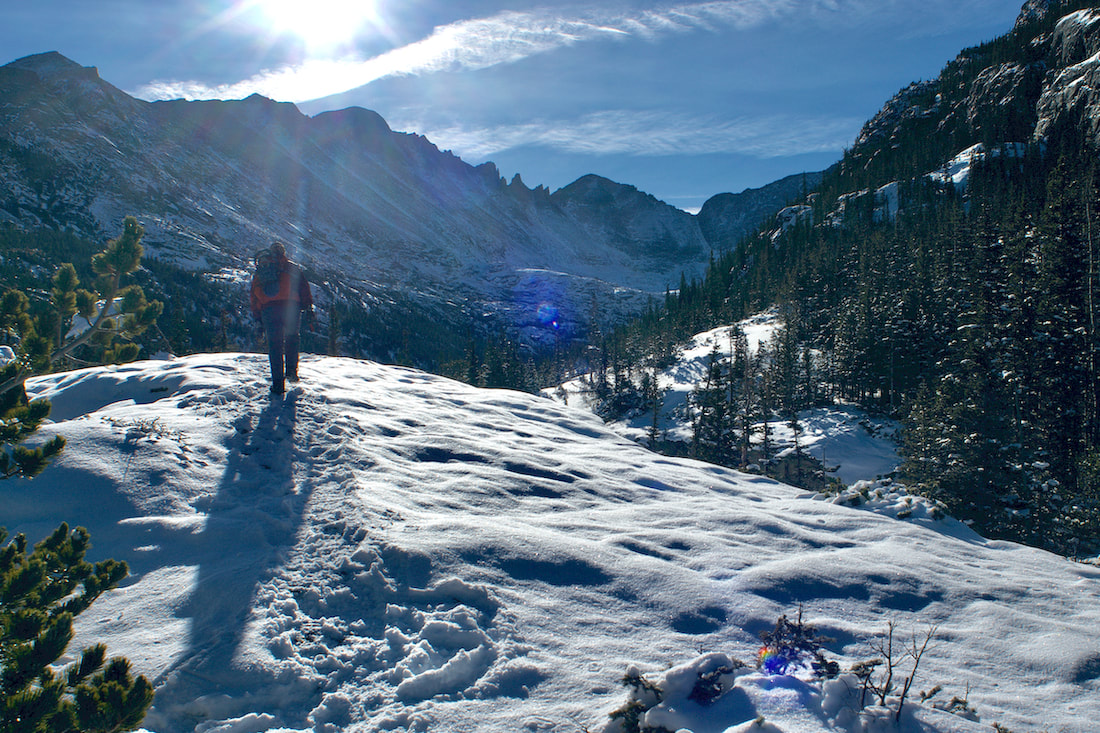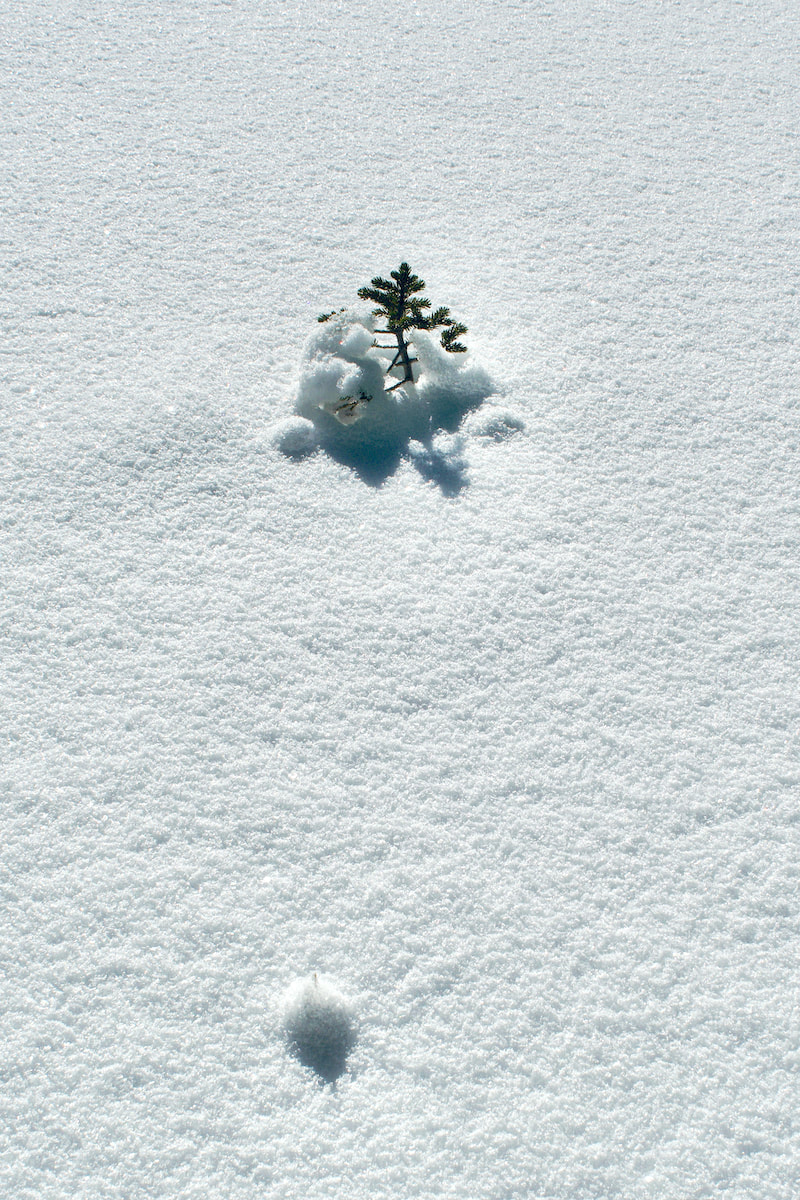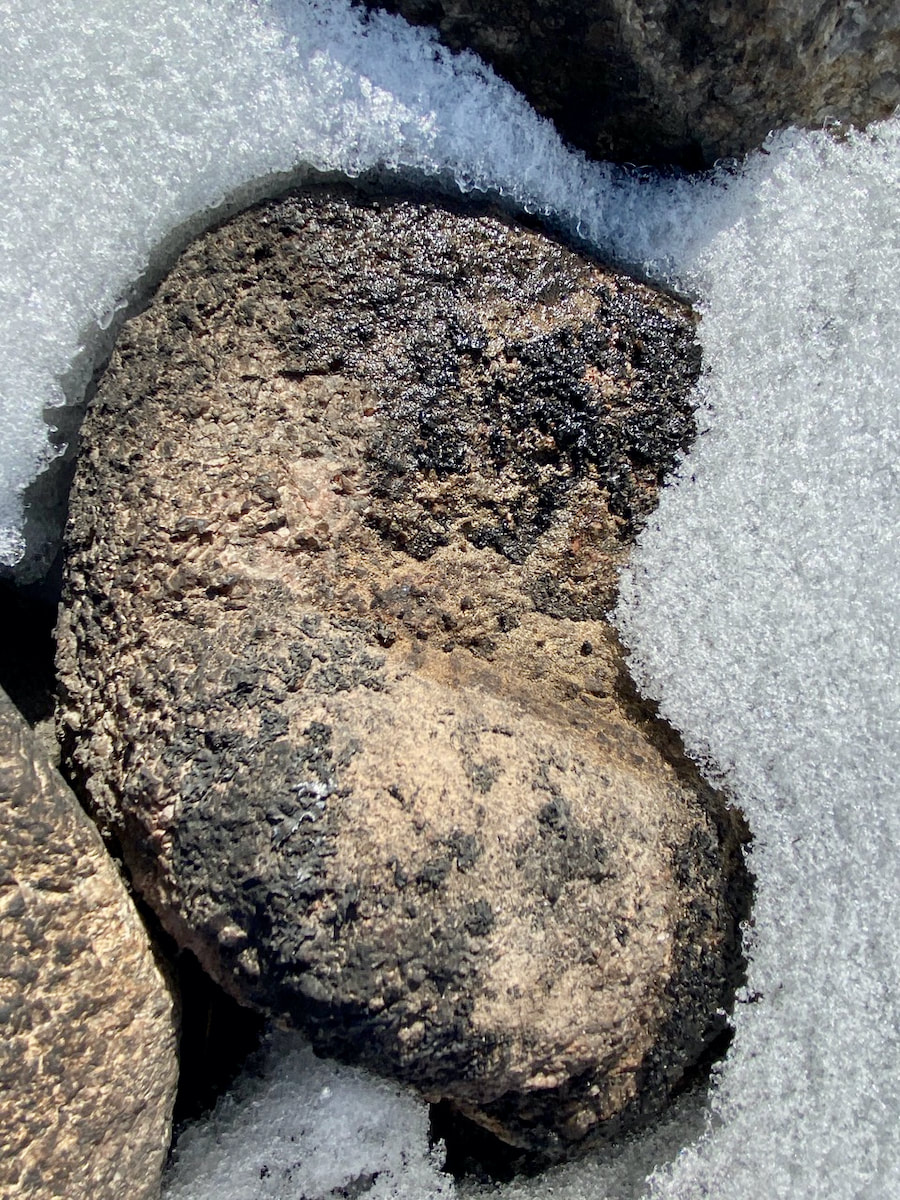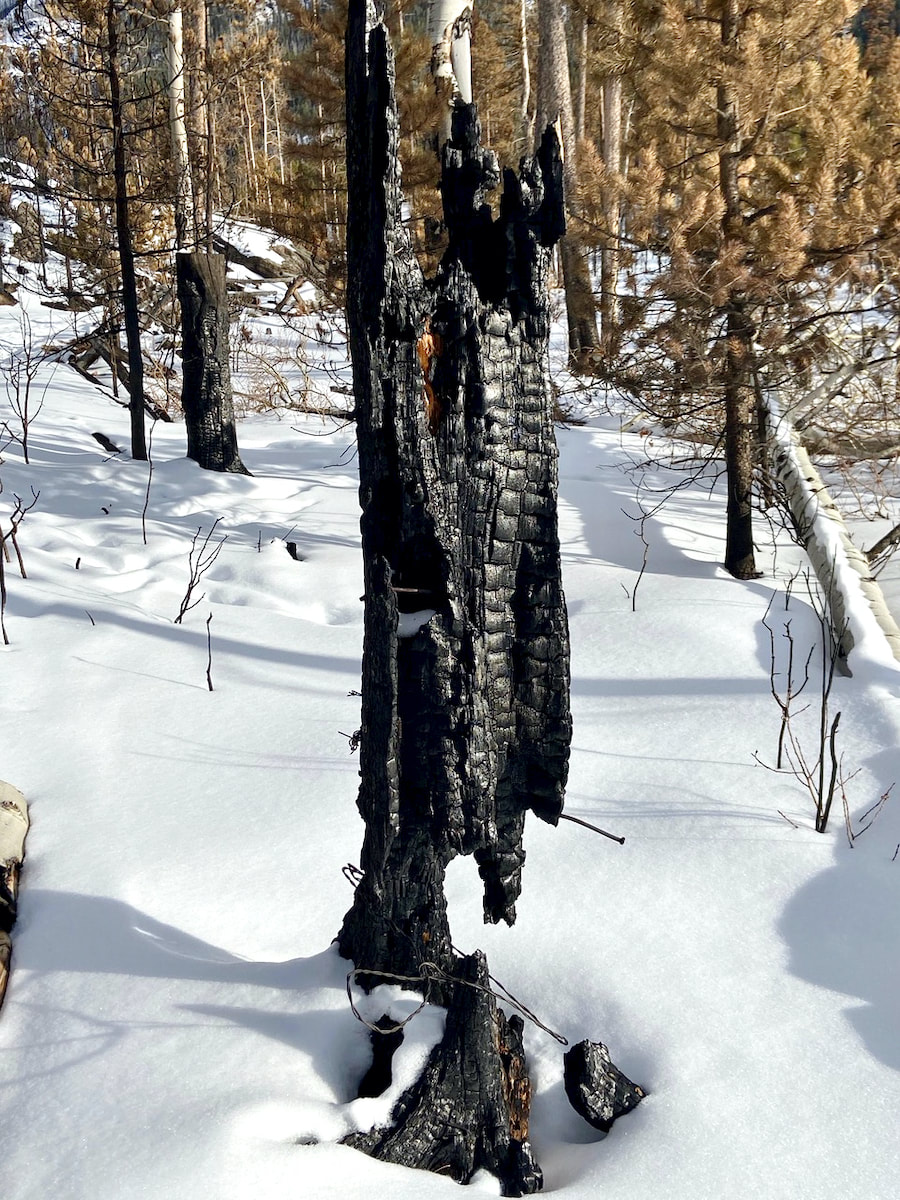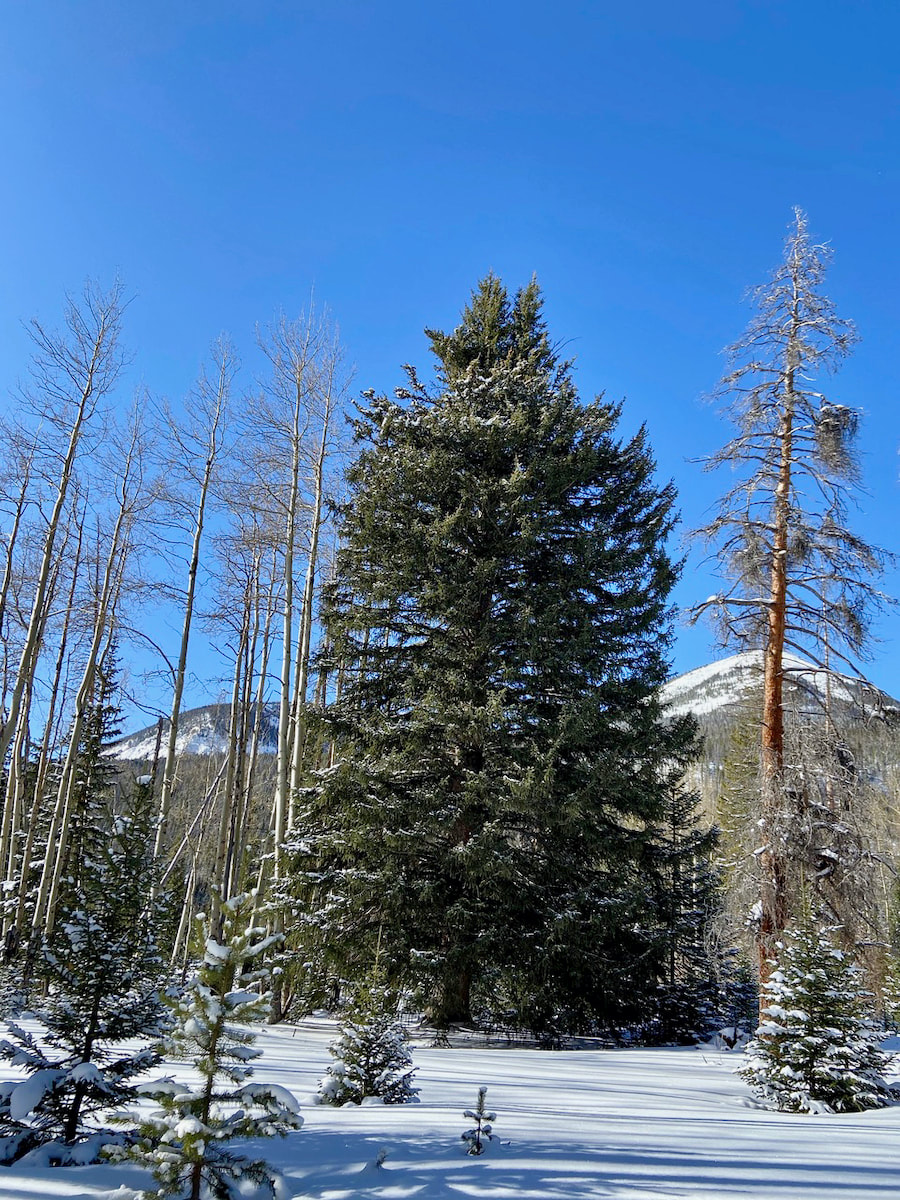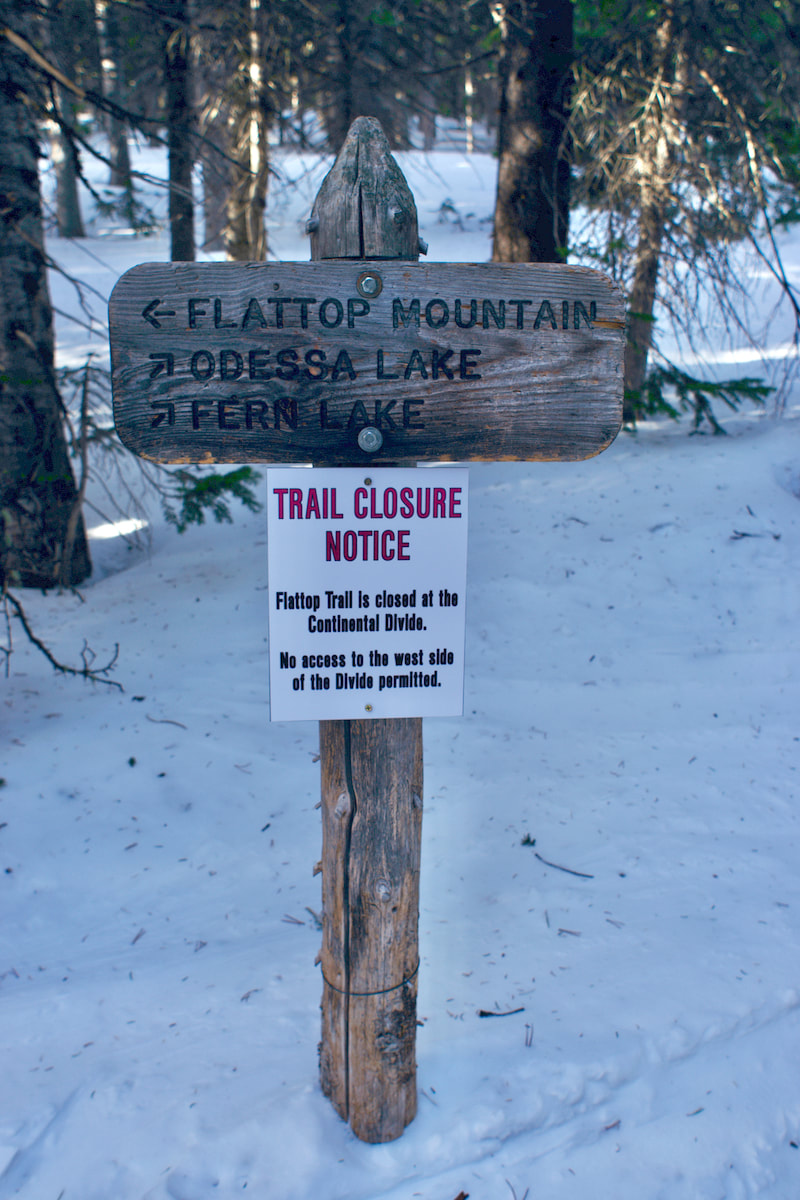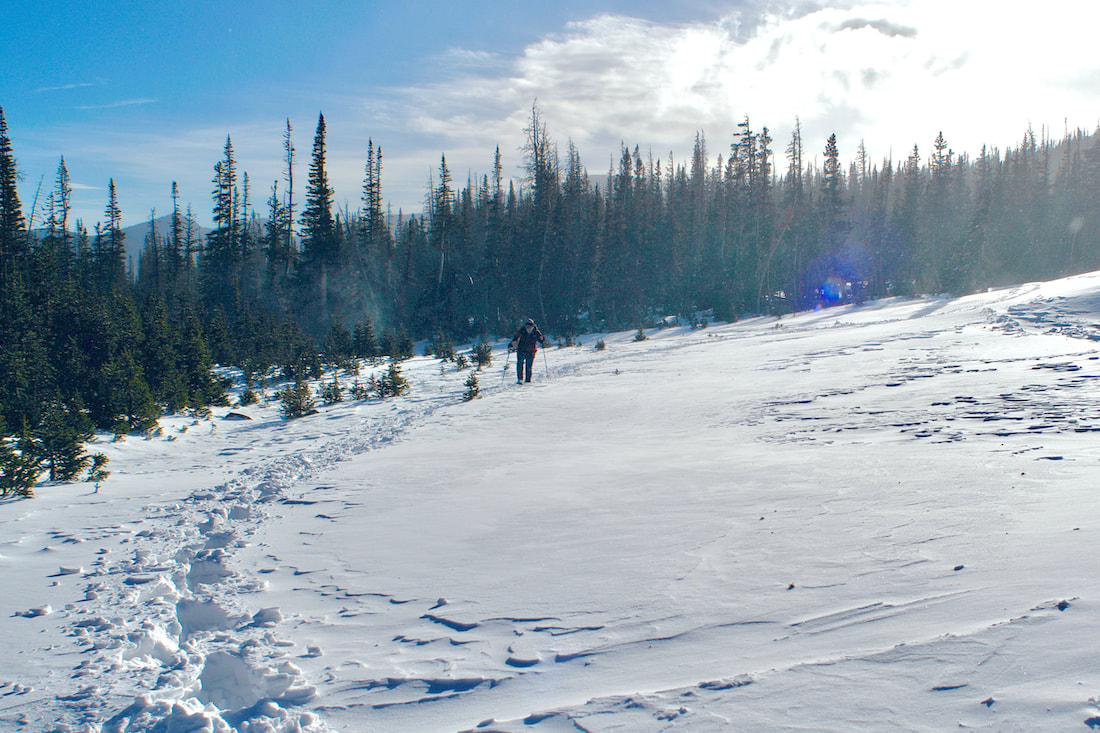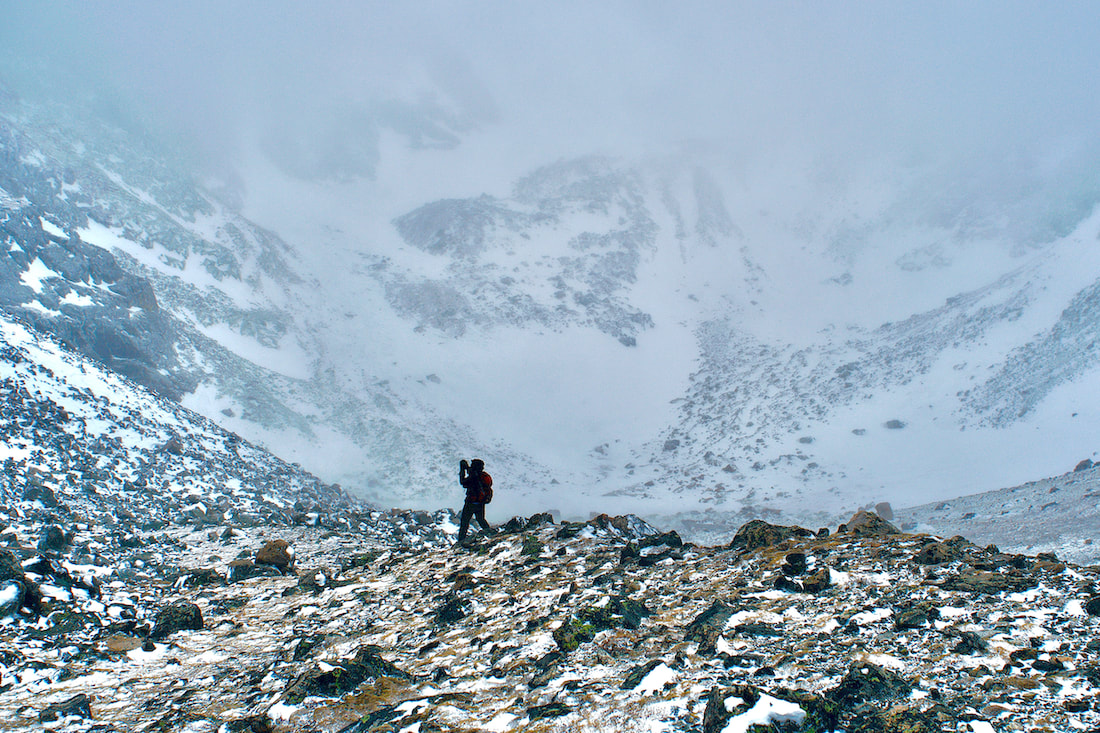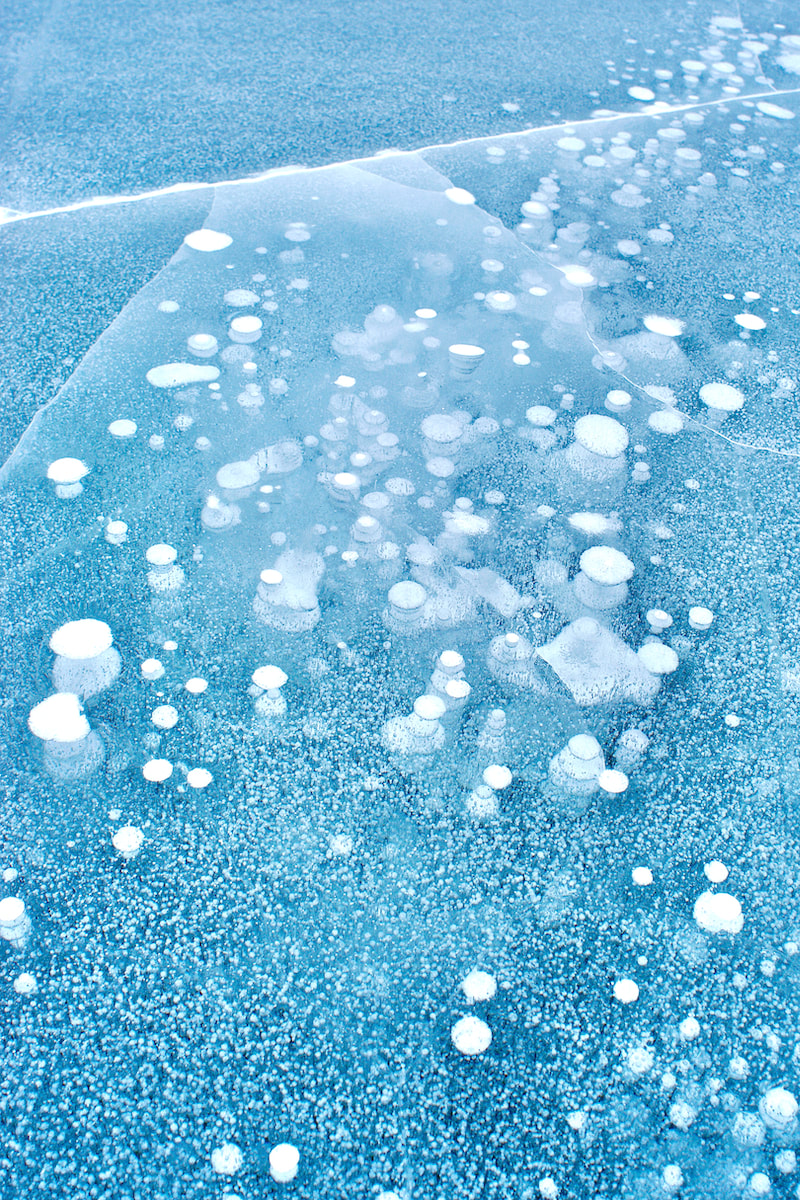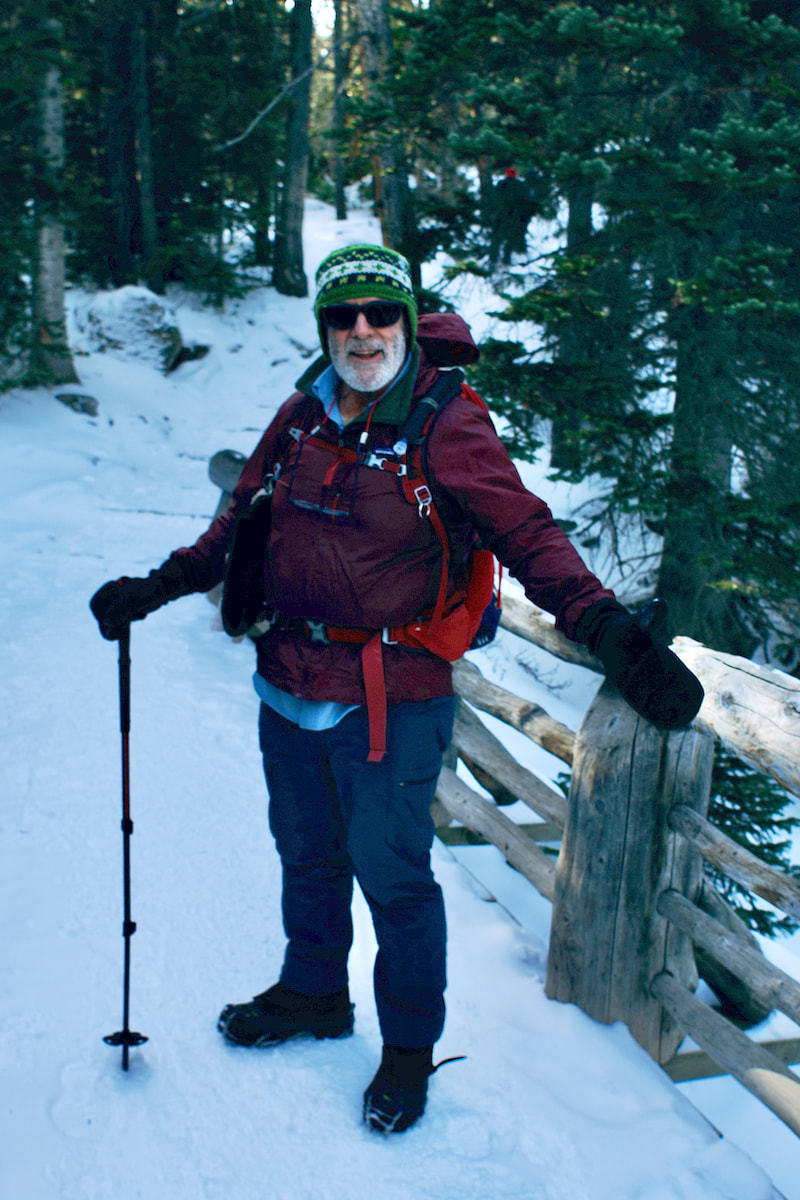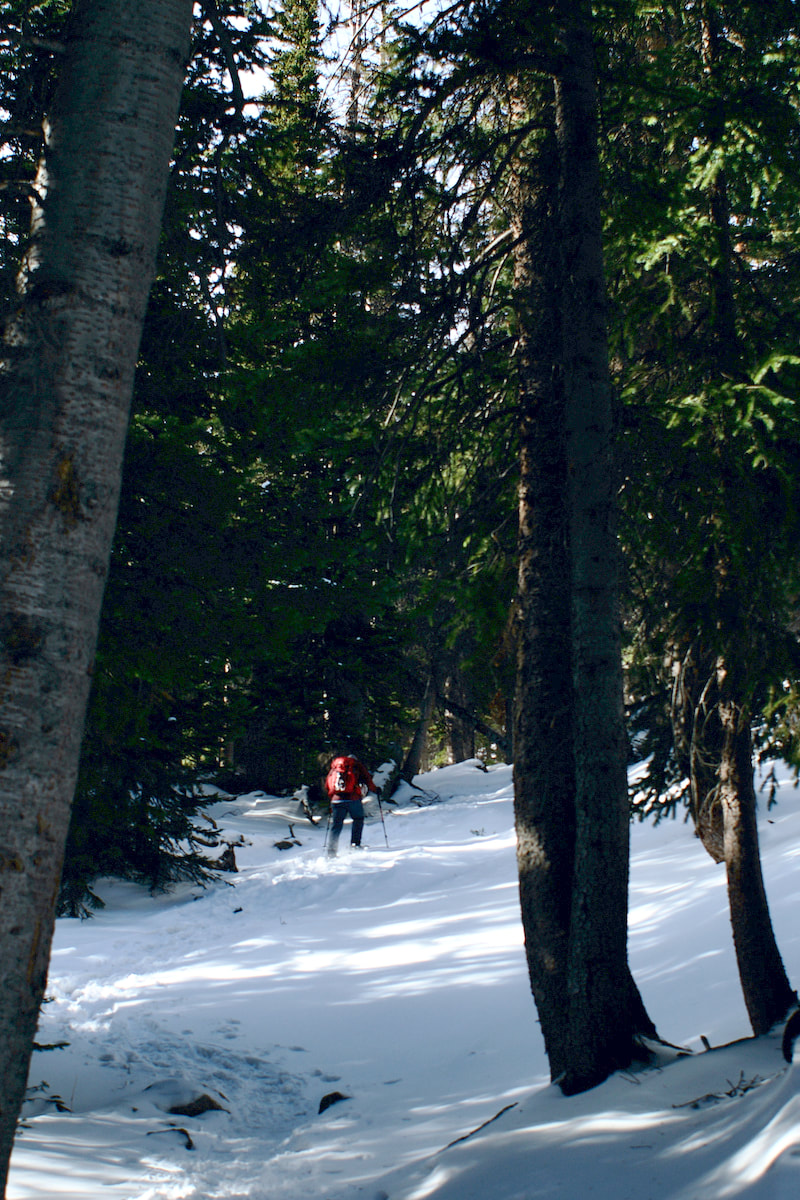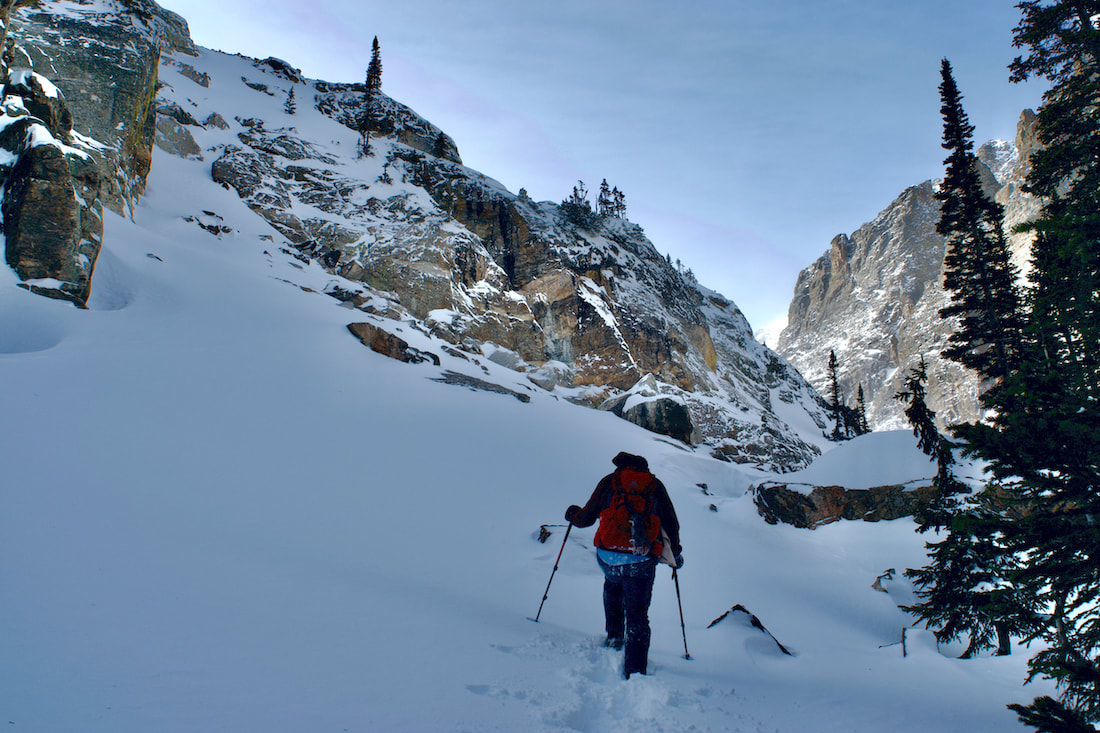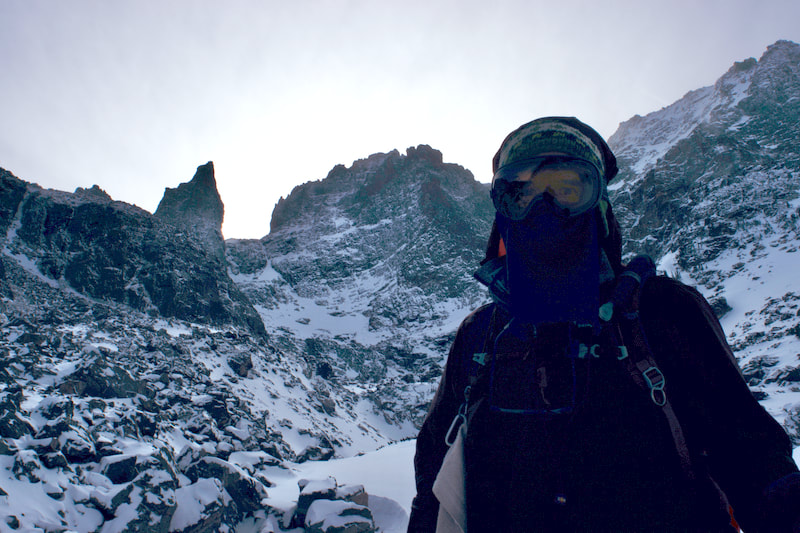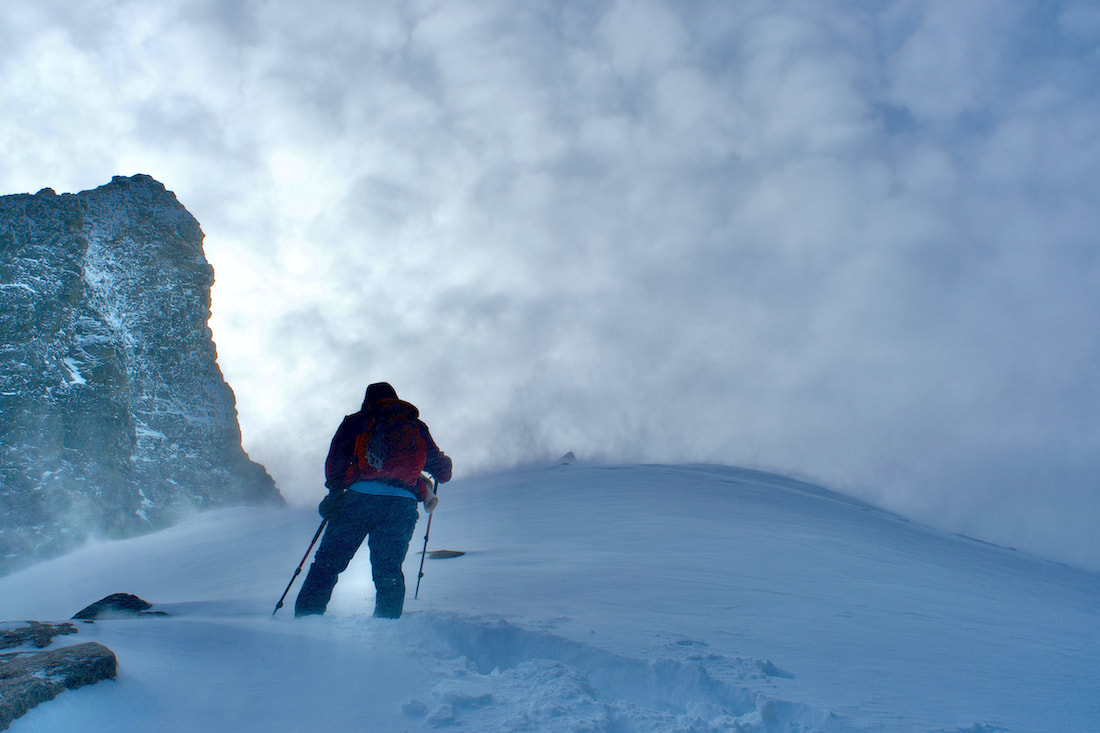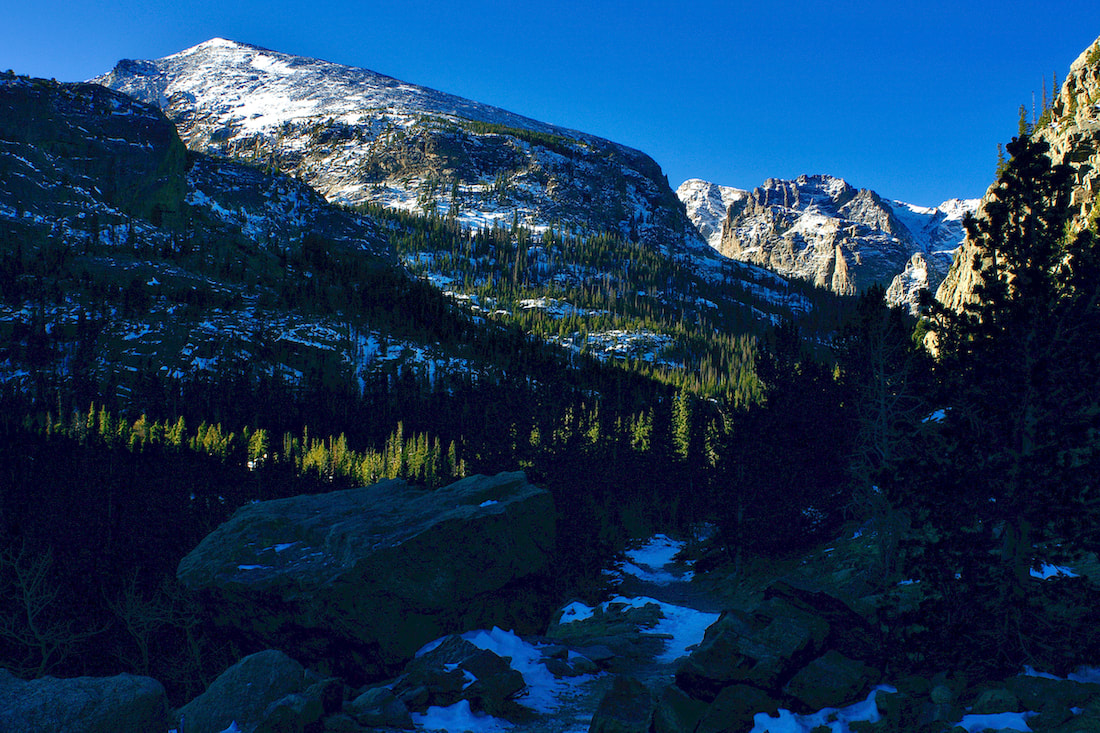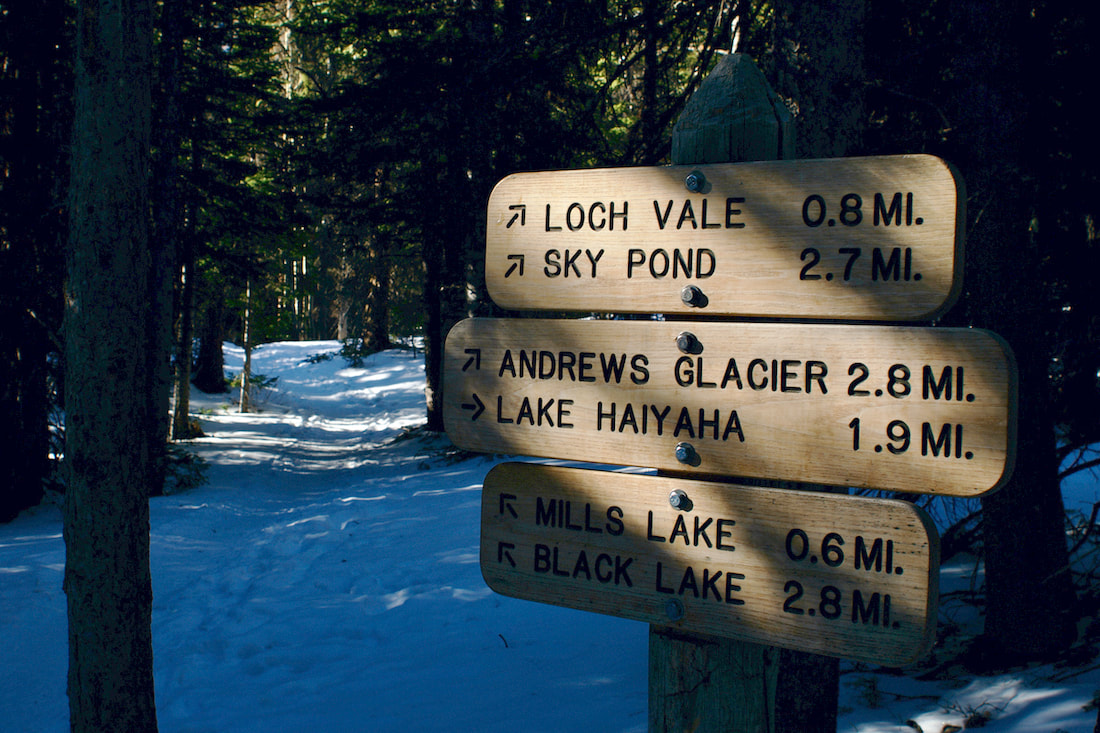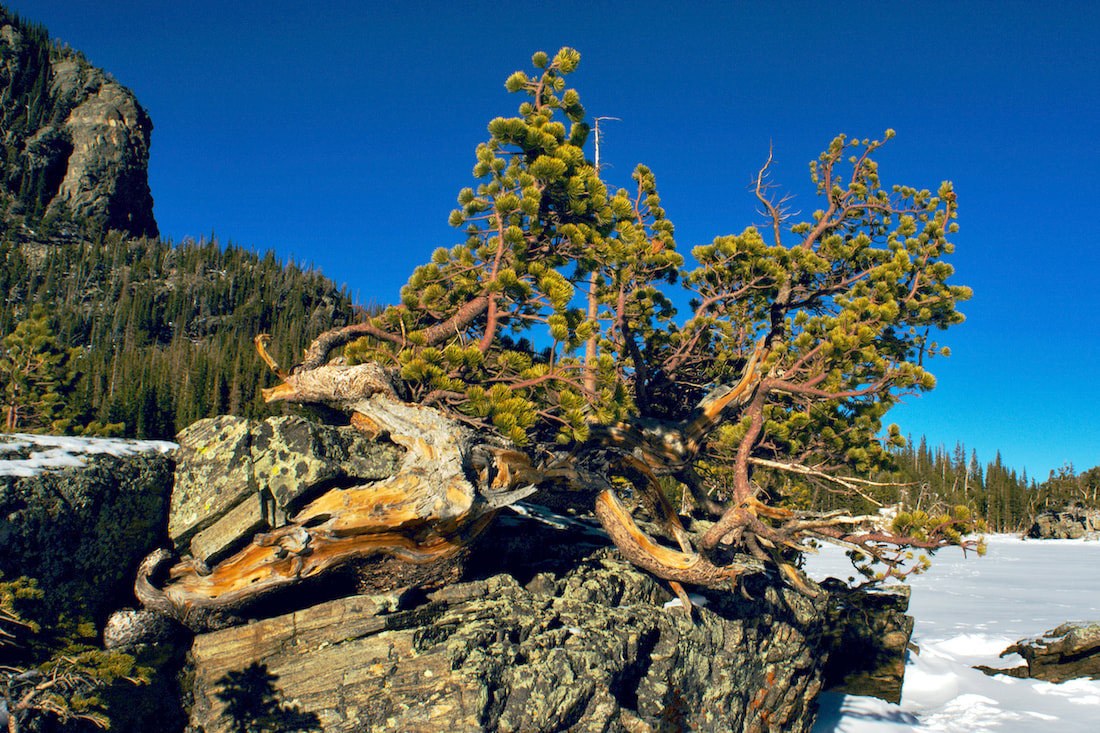|
Notes from the
Trail |
Hike Rocky Magazine articles
|
by Marlene Borneman Go to the winter woods: listen there, look, watch, and “the dead months” will give you a subtler secret than any you have yet found in the forest." Fiona Macleod, Where the Forest Murmurs Hike Rating: Moderate Distance: 6.6 Miles Round Trip Elevation Gain: 1,606 feet Sitting at 11,006 feet, Estes Cone can be a challenging peak in cold, snowy months. The trail most often used in winter is located at the Longs Peak Ranger Station at 9,400 feet. The Ranger Station is not staffed in the winter. Trail and weather conditions can change in a heartbeat especially in winter so check ahead with the Wilderness Office. There are days carrying snowshoes is a must as the start may only require spikes or no devices, but later the trail can become deep snow and could stop one in their tracks! The start climbs steadily for a half mile to the junction with the Eugenia Mine, Storm Pass and Estes Cone trail. Leave the Longs Peak Trail and turn right heading towards Eugenia Mine and Storm Pass. This section of trail is surrounded by aspen and conifer forest and loses a bit of elevation before reaching Eugenia Mine. You may spot moose and often snowshoe hares. Approach a small footbridge crossing Inn Brook and arrive at the Eugenia Mine ruins. In the early 1900’s a miner from Chicago settled at what is named Eugenia Mine with his family to mine for gold. After a few years of laboring with no results he abandoned the site. Remnants of a log cabin, rusty pans and mine tailings are all that is left. It is enjoyable to explore the site and imagine the life attempting to mine for gold. Of course, nothing leaves the Park so please leave any item where found. About a half mile further a lovely meadow is reached named Moore Park which is often blown clear of snow. This spot provides a nice view of Estes Cone’s summit. Continue through the meadow entering the trees once again and coming to a junction with Storm Pass and private property. Take a left heading northwest to Storm Pass. At this point the trail can become windblown with snow drifts making it difficult to follow in winter. Climb 2.6 miles to Storm Pass with another trail junction. At this junction it is 0.7 miles to the summit with some difficult terrain to cross: snow covered rocks, ice and tree roots. Turn east toward the summit of Estes Cone. The snow/ice-covered trail can be difficult to follow. If proper equipment, (i.e. spikes, snowshoes, and warm clothing), is not carried it can be dangerous to continue, so turning around is ok. Spikes and/or snowshoes are necessary most of the time to reach the summit from here. The last half mile becomes especially difficult if one is not familiar with the area as the trail climbs very steeply up several switchbacks through a thick forest. There are cairns along the trail; however, these maybe covered in snow. Climb up the switchbacks, reaching the top of the ridge before veering south until a steep gully is reached. Before climbing into the gully look west for a breathtaking view of Longs Peak. This gully has large loose rocks to negotiate that are often ice covered so take care and go slowly. Top out on the rock outcropping and turn east heading through fine looking limber pines to another gully to scramble to the summit. The summit of the cone offers outstanding views of Longs Peak, Twin Sisters, the Mummy Range, Lily Lake, and the Estes Valley. Retrace your steps back to the trailhead. Five-point moves may be necessary coming down (hands, feet and butt) especially in the gullies and on the switchbacks!
0 Comments
This winter, why not try a trek to a Rocky Mountain National Park classic, Chasm Lake.
It is important to pay attention to the conditions, namely the weather. Besides looking for a sunny day, check the winter weather for the wind forecast; strong winds and blowing snow create hazardous conditions. When winter trekking on this trail, plan to bring both snowshoes and good traction devices like spikes, and pay special attention to winter wear. When deciding your winter wear, if it’s a good weather day, the conditions could be anything from almost balmy to bitter cold in the shade. Be prepared to layer up or down. If, for whatever reason, you have decided to go up on a nasty day, goggles are a must. But do check the weather the night before. The Trail Out of the car, you are at the Longs Peak trailhead with a beginning elevation of 9,400’. The lake from here is 4.2 miles away and 2,360’ higher. The trail begins in smaller lodge pole pine, the pines are not as tall here because of the higher elevation. Although it is also possible that the area could have been logged during the time of the Enos Mills Longs Peak Inn era of the early 1900’s, and so they may not be that old either. The January trail is likely to be completely snow covered and snowshoes work best for this first part in the trees, although depending on how long it’s been since it snowed, you might find the trial is packed enough that snowshoes are not necessary. 'Tis better to carry them and not need them than to not carry them and wished you had. It's also better to wear them than to post hole and wreck the trail.
Shortly after that, the trail switchbacks at about a 140 degree angle to the south and you begin to steadily gain elevation. You are rewarded at the end of that traverse with a switchback at Alpine Brook, a nice little babbling brook in spruce and probably why the trail goes to this point. It makes for a pleasant early resting spot, even in winter.
Not long after, the trail turns left crossing tiny Larkspur Creek and begins a traverse up and across an east facing slope, so there are more spruce now. Four switchbacks more continues to gain elevation before crossing one more notable bridge at Alpine Brook. At this point, you are traveling through the treeline transition zone, an elevation above which no trees grow, about 11,000’. Isabella Bird wrote upon entering the Estes Valley that, “The scenery is the most glorious I have ever seen, and is above us, around us, at the very door.” So it is as you enter into the open alpine zone and Longs Peak comes into view. Here you will find an entirely different looking landscape than the one you just walked out of, and potentially an entirely different weather situation in the winter. From here, the lake sits another 797’ higher, and the trail is all in open, exposed alpine terrain. Consider the weather from this point on. During the winter months, the summer trail in this open area can be difficult to follow due to the trail being covered over with blowing snow. Even the winter trails made by previous snowshoers can get covered over easily and you may find yourself having to make your way as best you can picking up the trail when it becomes is visible. Because this stretch can be sketchy with the wind blowing the snow off in most areas, while accumulating in other areas, switching over from snowshoes to spikes can make the travel go easier. Also, make sure your wind jacket is handy if you have not put it on yet.
“When I woke, the moon was high shining through the silvery branches, whitening the bald Peak above, and glittering on the great abyss of snow behind, and pine logs were blazing like a bonfire in the cold still air. My feet were icy cold that I could not sleep again, and getting some blankets to sit in, and making a roll of them for my back, I sat for two-hours by the campfire. It was weird and gloriously beautiful.” You will be traveling in a west to south west direction, steadily gaining elevation as you go. You are looking for a saddle of sorts on the south ridge of Mt Lady Washington up ahead. Once reaching that low spot on the ridge, you will find a trail sign indicating a trail branching off to the right, leading towards Granite Pass for Longs Peak and traversing the north eastern side of Mt. Lady Washington. However, our trail at this point starts across and under the south east ridge to begin the last third of your hike. Snow accumulates along this next stretch of trail. Snow blows over the ridge you are now trekking under and settles, creating a snowfield that can last clear into June. Thus, the snow that falls here can be wind protected and softer, allowing for White-tailed Ptarmigan to nestle into the hillside among the rocks. Besides being somewhat wind protected, there are many days of sun along here and you might notice them sunning while nestling. But they can be amazingly difficult to see. You may see one at first, but then as you stare at it, you might notice a few more black eyes blinking at you. They might also be sitting on willow branches that they can poke their beaks down to and nibble on. According to the Rocky NPS website, they predominantly eat buds, leaves, and seeds, and are highly dependent on willow, especially in the winter. "They have been known, like other members of this group, to swallow grit to help grind coarse food in their gizzards. White-tailed Ptarmigans are permanent residents and lead a very sedentary lifestyle in winter. Warm weather may stress the White-tailed Ptarmigan. It can be seen bathing in snow when the temperature is higher than 21° C (70° F)." Rocky NPS
After a couple of tricky spots on this snowfield, you finish the traverse and cross onto an open flat alpine meadow, a large ledge left long ago by glacial retreat. The water from Chasm Lake, still higher up and not in sight, travels through this narrow spot before waterfalling down to Peacock Pool below. You will have to find a way across this very short stretch of frozen water, which can be polished and quite slick. But soon enough you are onto the open flat area and looking up at the looming cliff walls that is The Ships Prow emerging between Meeker Mtn and Longs. Searching for the final way up to the Lake, the direction to head is south, across the meadow. The trail here is often blown clear and easy enough to follow. It will take you to the base of a rocky area. Carefully work your way up. And then finally the frozen Chasm Lake. Unless you happen to come up not long after a snow fall and before any wind, the lake will be clear of snow. There are very large rock areas all over along the eastern edge of the lake that are enjoyable to hang out on in the summer, but you could be greeted with a cold steady breeze during the winter. Also, the sun sets behind Longs very early in the day this time of year and once that sun is gone, the temps can drop quickly. Sometimes sunny pockets protected from wind can be found among the rocks to re-hydrate and re-nourish before making the return trek. It can also be a good spot to pull out a thermous of something warm to drink or even fire up a small cook stove to heat up water for soup. Because once are here, you have made it, and it is worth clinking your water bottle with the rocks to celebrate this place. This amazing place. This weird and gloriously beautiful place. by Marlene Borneman, author of Rocky Mountain Wildflowers 2Ed., The Best Front Range Wildflower Hikes, and Rocky Mountain Alpine Flowers. Hike Rating: Moderate Distance: 7.6 miles from Trailhead plus 1.4 miles on road from Shuttle/winter parking. Total 9 miles round trip in winter Elevation gain: 1,390 feet Rocky Mountain National Park offers a variety of winter hikes. Wearing winter spikes, snowshoes or skis are the most suitable forms of recreation. A popular destination in this frosty season is Fern Lake when the trail transforms to a carpet of shimmering snow. The trek to Fern Lake begins at the Summer Shuttle Stop 0.7 mile from the Fern Lake Trailhead as the road to the trailhead is closed from end of October through May. Be prepared for current conditions and weather by checking ahead at the Wilderness Office. Both trail conditions and weather can change rapidly. Rocky is often referred to the Land of Extremes for good reasons! Early in the season you may be wearing spikes for an icy start, but as you gain elevation you may need to switch to snowshoes. It is good practice to carry snowshoes strapped to your pack to avoid postholing. Postholing is a term used when with each step you are sinking deep into the snow past your knees which makes walking very fatiguing. Best to avoid. If there have been recent heavy snowfalls, you can start from the parking lot in snowshoes. Top Left: The icy Pool of the Big Thompson River. Top Right: Keep your eyes open for moose! Bottom Left: Spider on the snow. Bottom Right: Moose print. All photos by Marlene Borneman. Once at the trailhead it is an easy 1.75 miles hike up to The Pool, a deep collection of swirling water in the Big Thompson River. Hiking in the snow provides opportunities to investigate animal tracks, deer, moose, even field mice. Often these animals are seen along the snow-covered banks of the beautiful Big Thompson River. Spiders of all varieties may be seen on the snow in search of tiny insects. About a mile and half from the trailhead look to your right (north) “The Jaws” maybe visible. “The Jaws” is a large ice formation formed from water dripping down steep rock slabs creating a dramatic icefall. Technical ice climbers like to take on this challenge. Old Forest Inn trail sign and burn scar from the 2020 East Troublesome Fire. Photos: Marlene Borneman The next feature you reach is a backcountry campsite named The Old Forest Inn. The Forest Inn was one of the early rustic lodges located in Rocky Mountain National Park, built around 1913. The Forest Inn provided peaceful rest for hikers. In 1959, the remains of the Forest Inn were removed by the Park Service. The trail now becomes steeper with several switchbacks up to Fern Falls. Here the snow can become very deep. You will see evidence of the 2020 East Troublesome Fire. Stands of black, scarred trees in the glistening snow create a desolate landscape in winter. However, Fern Falls creates an intoxicating sparkling spectacle in the cold air. Fern Falls shows many faces in winter months, either completely covered in snow with only sounds of rushing water underneath, frozen water encased by snow sculptures, or cascades roaring down adorned by large sharp icicles or a mosaic combination. Leaving the falls, continue up a few more switchbacks. Soon you will see a hitch rack for summer horseback riders and just up a short hill Fern Lake comes into view. The shores of Fern Lake have a history of providing a restful spot for fishermen, hikers, and Park Rangers. Here stood Fern Lake Lodge, built in 1910 by Dr. William J. Workman from Kansas. His main interest was fishing and the lodge provided lodging and meals with some fishy stories thrown in. Later there were many others who managed the lodge with Rocky Mountain National Park taking over the property in 1958. Fern Lake Lodge was permanently closed in 1959. Due to the hazards of the deteriorating structure, the Park Service burned the lodge in 1976. Look slightly to the north and you will see the remains of the Fern Lake Patrol Cabin that was destroyed in the 2020 East Troublesome fire. This beautifully built sturdy cabin provided Park Rangers shelter when patrolling on official duty. In 1989 this Patrol Cabin was placed on the National Register of Historic Places. Maybe the cabin will be rebuilt one day. Fern Lake lies at 9,540 feet offering a striking vista more days than not with sunny blue skies overhead. Views of 12,129-foot Notchtop Mountain, 11,586-foot Little Matterhorn and 12,331-foot Knobtop Mountain make a picture-perfect backdrop to the shimmering frozen lake. Spike season has returned to Rocky Mountain National Park. That is to say, if you are heading out for a hike in the Park, you should plan on winter trail conditions and it would be a good idea to have some kind of traction footwear handy. Current conditions can create slick and icy trails. November is a good month to get acclimated for winter. Regulating body temperature while hiking during this transition season can be tricky depending on elevation, aspect to the sun, and of course the daily weather conditions. Be prepared to stop frequently to either layer-up or dress-down. Our trail pages offer up National Weather Service trail specific weather conditions and forecasts to help you to be better prepared. Check them out to know before you go. And don't forget to admire this season of change. Beautiful ice formations are forming along open water, various signs of wildlife can be noticed as they prepare for the winter months, and the lower sun on the southern horizon creates dramatic light and shadows. Changes are in the air during the month of November. We are now 36 days away from Winter Solstice. Dear Mtn Trail
A good trail for snowy mountain vistas on a sunny day. With the sun being lower to the horizon this time of year, try to be on the trail before 10am to capture the best lighting on the mountains for photos. Lumpy Ridge Loop
A lower elevation, longer loop hike. Good sunshine will keep the beginning of this trail along the south base of Lumpy Ridge snow free for much of the year, and some years the entire trail can remain snow free into November. But right now you can count on snow and ice covering over much of the trail on the back side of this hike. After your hike, stop in to Lumpy Ridge Brewery for an apes beer! Emerald Lake Trail
A good hike to get an early taste of winter. This alpine lake trail is popular no matter what time of year. Use this shorter hike to make sure you have all of your winter gear ready to go for this season. November is the month winter moves down to lower elevation in Rocky Mountain National Park. It can be a challenge for hiking as you will need to be ready for any and all conditions. So get out and enjoy the seasonal transition! by Marlene Borneman "Go to the winter woods: listen there, look, watch, and “the dead months” will give you a subtler secret than any you have yet found in the forest." Fiona Macleod, Where the Forest Murmurs The name Wild Basin dates back to the early days of Enos and Joe Mills. Wild Basin is the southeastern section of Rocky Mountain National Park and designated as wilderness. It holds the headwaters of the North St. Vrain River and is filled with many lakes, creeks, and waterfalls. It is also home to a number of the most remote and rugged high peaks in the park. Wild Basin is indeed wild! Sandbeach Trail January 4, 2024 - Little to no snow describes the beginning of the Sandbeach Lake trail early this year. In fact, there was no need for snowshoes or even microspikes until about 1.5 miles up the trail. Icy spots were manageable and in many places the trail was bare. The start of the trail is on the south facing slopes of a moraine exposing it to the sun. Nonetheless, I found the lack of snow very unusual for January. Meeker Park Junction Approximately 1.5 miles up the trail we reach the Meeker Park Junction. At this point we hiked west where the trail follows a north facing slope. Here the snow became significant in the trees; however, the trail was well packed requiring only microspikes to be worn. It was very pleasant hiking along this section traveling through a thick conifer forest and aspen groves. Soon, we cross Campers Creek on a short foot bridge. Hunters Creek at 3.2 miles At 3.2 miles we cross Hunters Creek over another foot bridge. Hunters Creek is a dazzling stream in any season. The winter snows and frigid temperatures transform this creek to a magical scene adorned with dramatic ice crystals and snow sculptures. In summer months its banks are decorated with spectacular wildflowers! At this point the trail becomes steeper and we begin the climb toward the Sandbeach Lake. Sandbeach Lake Sandbeach Lake sits at 10,283 feet. This destination is very popular in summer months as it hosts four individual campsites and one group site. The shoreline is just as its namesake implies. A beautiful serene setting surrounded by fine sand and large boulders complete with spectacular views. To the south St. Vrain and Meadow Mountains with massive Copeland Mountain capturing the scene. To the north there are views of Mount Meeker and Longs Peak. Be cautious about walking out on the lake even on the coldest of days as it is often not completely frozen. The author enjoying lunch at Sandbeach Lake A Snickers bar is a favorite for lunch. Easy and light to carry with little trash to pack out. Winter months offer solitude in Wild Basin. Moose are often seen at the lake and wandering the trail. On this day we did not see any wildlife including no birds. This is rare as the Gray Jay aka “camp robber” is typically all over the place or rather all over your lunch! Sandbeach Lake: Sandbeach Lake elevation: 10,283 Round trip from Sandbeach Lake Trailhead: 8.4 miles Elevation gain: 1,943 by Marlene Bornean (Editor's Note: This article compares winters from 2020 through 2023 with photos showing a variety of conditions and what you can encounter while hiking up to and summiting Flat Top Mountain in Rocky Mountain National Park. “Alpine Weather bounces between sunlight and storms, strong winds and balmy breezes, violent weather and surprising calm… resilient plants, insects, birds, and mammal, flourish in harmony with the land.” Joyce Gellhorn, Song of the Alpine Rocky Mountain National Park provides year round recreational opportunities. In winter months back-country skiing, snowshoeing, ice skating and trekking on spikes are popular activities. With increasing winter visitation in Rocky the trails are often packed down enough spikes are the only equipment needed on popular trails. I prefer to ski the trails when the snow conditions are prime. My husband, Walt, and I are out in all weather and all conditions since Rocky is our backyard. One must be equipped and prepared in any season but particularity in winter months. Being familiar with the Ten Essentials as well as packing layers is the key to having a safe and fun winter experience. Knowing when to turn back is a “must” skill. November 3, 2021 was very cold with extreme winds on the Flattop trail. We hiked above treeline but did not make the summit due to the harsh conditions. A frigid day with an unforeseen surprise, spotting a covey of white-tailed Ptarmigans on the snow covered tundra. I heard them before seeing them. Their clucking, soft hoots caused me to stop and search for tiny black eyes and bills in the pure white snow. I saw one, then two, then over a dozen in the deep snow. White-tail ptarmigans are the only birds to live on the alpine tundra year round with white plumage in winter and gray-brown in summer. Breeding males have a red eye comb. In winter months they use snow drifts for shelter and sustained themselves on willow buds. White-tailed ptarmigans have a thick layer of feathers on their legs, feet and toes not only adding warmth but acting like snowshoes. The day reminded me of a quote by John Muir, “…the blessings of one mountain day; whatever his fate, long life, short life, stormy or calm, his is rich forever.” This is me (Marlene) at the summit of Flat Top Mountain. What a contrast in weather conditions compared to one year earlier! This is a comparatively warm windless day on the summit. Nearly one year earlier, on the same mountain, we experienced significant cold and challenging wind (see the very top photo of this article). And isn't that why we keep coming back? Our mountain experiences, even on the same summit, are never the same but always wonderful. December 2023. Another very cold winter day on the Flattop Mountain trail. However, we did not have much wind until we reached treeline. No sightings of ptarmigans but their tracks where everywhere! December 21, 2023. This day did not reveal ptarmigans, but another creature known to the alpine tundra: the fascinating pika. Even though they belong to the rabbit family they appear more like a guinea pig! Pikas live in colonies on talus slopes making their homes among the rocks. They do not hibernate. They simply tolerate the harsh winters. In summer months you may see them harvesting their favorite food, alpine avens. Pikas store avens and other plants in “hay” piles deep in their rocky homes. They feed on these “hay” piles all winter. Sharp squeaks are their way of communicating to other pikas and alerting to danger. On this day we observed a pika quietly sheltering against a large boulder from the fierce strong winds. Dusty grouse are often seen in the subalpine forest on the Flattop Mountain Trail. Grouse are rather large birds weighing up to three pounds. They have a pale gray band on a rounded tail. Dusky grouse enjoy the high country in winter and in spring move down slightly to lower meadows for nesting. December 2023. Marlene near a very cold Flat Top Mountain summit. Every winter season is different as is every day is in the high country of RMNP. So far, this 2023/2024 winter season has been lacking snow. Here the trail has a thin covering of packed snow. No need for snowshoes just spikes for traction. These two photos show arctic conditions and strong gale force winds sculpturing snow into fine art during the winters of 2021 and 2023.. This overlook makes for a great second breakfast or snack stop. It provides shelter before reaching treeline with a stunning view of Emerald Lake below, Mills Lake in the distance and the striking Longs Peak massif. During the winter of 2020, as soon as I stopped at Emerald Lake Overlook, a curious and rather bold pika came right up to my boot! Flat Top Mountain and Flat Top Mountain Trail Flattop elevation: 12,324 Round Trip from Bear Lake: 8.8 miles Elevation gain: 2,874 by Dave Rusk
The forecast was billed as clear and mild, but there was a high level of thin clouds screening the sun with a mild breeze. Walking out of the treeline, there was also a dark and somewhat ominous lenticular cloud hovering like a giant UFO off somewhere over Netherland, or maybe Ward. The tundra above treeline had been swept clear of any deep snow with the only snow accumulations occurring on the leeward side of willow shrubs. The Diamond of Longs came into view, obscured partially by Mt Lady Washington. We also could see our immediate destination, Granite Pass, to the north. We advanced to the Chasm Lake trail junction without difficulty, and continued the traverse to Granite Pass where we observed more lenticular clouds off to the north. We had anticipated an increase in wind once on the west side of Granite Pass, but it continued to stay mostly calm with occasional gusts, pretty pleasant for this first day of February. Threading through the Boulderfield now, we turned our gaze to the north of Longs Peak along the north ridge to our destination, Storm Peak. Appearing as mostly a knob on the ridge next to the dominating Longs Peak, the summit of Storm is at a very respectful 13,326'. Having traveled the 6 miles to get to the base of Storm Peak, the unknown question we had was what kind of snow would we find. It needed to be hard enough to make solid steps in. We had brought crampons if the conditions warranted them. While there was some soft stuff layered on the surface, there was also some more solid footing underneath, so we continued to work our way up. The sun made more of an appearance moving into the afternoon and when the wind wasn't blowing, it felt a little balmy. But when those wind gust did come up, picking up and blowing small snow particles into our face, we had to turn away and wait for the gust to blow off. About three quarters of the way up, the slope angle became too steep for my comfort zone and I perched myself on a rock outcrop, pulled out a thermos, and took a coffee break while Kip completed the ascent to the ridge giving him a commanding view into the Glacier Gorge, with frozen Black Lake below and endless peaks to the west and north. With shadows starting to grow long in the afternoon light, we descend through the Boulderfield. Story and photos by Barb Boyer Buck A hike to Emerald Lake, that was the intention. It had lightly snowed overnight and the sky was a cloudless, cobalt blue. Most importantly, there wasn’t any wind. If you don’t know about the wind in the eastern foothills of Colorado – most notably in the valleys– well, It’s brutal. When air is forced over the Continental Divide and combines with Chinook upslope winds, the result is a cacophony of directionless and fierce wind. It’s just as crazy-making as the sound of a symphony warming up. When I was the renewable energy manager for the Town of Estes Park, my team thought perhaps wind turbines would be able to harness this crazy wind, but no. The wind comes from too many directions, is too fast (70-90 mph is not uncommon) and is never consistent. It’s either windy or it’s not, at least from October through April. I was excited to take a hike in the fresh snow with no wind. But it was a late start – we probably didn’t reach the Emerald Lake Trailhead until close to 1 p.m. I brought my snowshoes just in case, but micro-spikes and poles worked just fine. From its trailhead, Emerald Lake is 1.8 miles, so we figured we’d get there around 3 and have plenty of time to get back down before dark. It was nearly a month after Winter Solstice and the days were getting a bit longer.  Beautiful lighting, fresh snow, and fresh bunny tracks! Beautiful lighting, fresh snow, and fresh bunny tracks! But we were stopped quite literally in our tracks with almost every step. Snow doesn’t usually stay on the tress very long in RMNP (again, the wind) but that day, it covered every branch like fluffy icing, it sparkled in the full sun. The views along the way were spectacular and even with my cell phone, I was able to capture amazingly clear photos with great detail. This was a function of the afternoon lighting as well, which became increasingly rich as the day wore on. The Emerald Lake Trailhead is by far the most popular one in Rocky Mountain National Park, any time of the year. This day, a Tuesday in mid-January, was no exception. There were a lot less people than in the summer months, but the route was still fairly crowded. Here’s the etiquette for passing on the trail: those traveling up have the right-of-way. This is especially important when the trail is snow packed and/or icy. Further measures to take during these COVID times is to step aside, pull up your mask (if it’s down), and turn your back to the trail. Six feet of distance is just not possible on these popular trails. But I found myself stopping many more times than I technically needed to because of the stunning sights, especially of the Keyboard of the Winds formation on the “back” side of Longs Peak. The wind I was talking about earlier can make some unearthly sounds as it passes through this jagged ridge. The trail to Emerald Lake is packed full of amazing views and destinations – if you count Bear Lake (which is just a few steps from the trailhead) you see four lakes, amazing views of Longs Peak, many other stunning peaks, and beautiful geologic formations. 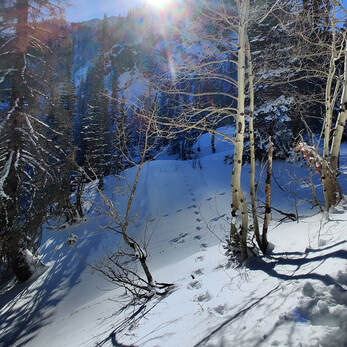 A bunny convention in the waning afternoon light. A bunny convention in the waning afternoon light. The first destination along the trail is Nymph Lake. In the winter, when the lakes are frozen over “winter trails” are established at each lake which cross over the frozen waters. Be very careful when you do this – sometimes the ice is thin in places you cannot see. Make sure that every lake is completely frozen on all edges before you try to walk across it. Views of Hallet Peak, first seen over Bear Lake, were now joined with the spires of Flattop Mountain.  The trail to Dream Lake The trail to Dream Lake A bit further up, and you reach Dream Lake with more stunning views of these features. Other things we noticed at Dream Lake were the limber pines (colloquially, twisted pines). These trees are actually shaped by the wind as they grow, and they are some of the oldest living organisms on earth. Some limber pines in RMNP date back over 1,000 years, according to a report by several federal forestry agencies, “Limber Pine Conservation in Rocky Mountain National Park,” published in 2013. At this point on our hike, the sun was setting – as it sank over the peaks shading Dream Lake, a final alpenglow lit the scene in a spectacular way. Emerald Lake was not to be, not that day. But it’s days like that which make me glad to be alive.
For me, rushing past the gifts of Nature, especially when they were laid out so beautifully for us to experience, is unforgivable. Emerald Lake isn’t going anywhere, and neither am I. By Dave Rusk It was 20 days past the Winter Solstice last week when we ventured up into the Glacier Gorge area. Even though it was still 60 days until the Spring Equinox, the snowpack at the trailhead was very thin and it seemed like it wouldn't take much warmth to melt it away. But on this day, the trail was still snow covered, the skies were blue, and there was hardly a wiff of wind. The morning temperature was still cold. We quickly moved up the trail to where the mostly snowed over Icy Brook dropping out of the Loch Vale joins with Glacier Creek. The snow was deeper here where it is sun and wind protected. We climbed up out of the drainage heading toward Mills Lake. The lake was frozen solid and there was still a couple of inches of snow on the lake that had fallen a few days before. We trudged across the middle of the lake to the far end. Once at the south end of Mills Lake, we followed the short drainage that connects Mills Lake to the small Jewell Lake and crossed it. At the south end of that lake, there was an area where Glacier Creek flows into Jewel Lake where the snow did not stick, like maybe the warmth of the water melted the snow, but left these odd puff balls of large flakes. It was kind of an odd phenomenon that was hard to explain. After Jewel Lake, we returned to the trail and worked through the blowdown area from a Nov 2011 wind event and started to move into the upper part of Glacier Basin with Arrowhead appearing to the west and then finally McHenry's Peak. Once at Black Lake, also with a thin layer of of snow on it, we moved up the drainage that leads to the upper hanging valley. Part way up, now at about noon, with the sun at it's zenith for the day, we stopped for a bite to eat and take in the amazing view. The day had been warm and we were casual on our break. In the summer, there are lots of seeps, water that flows out of the cracks on down the rock face. These had turned into ice flows as the winter temperatures settled in. Up to this point, the trail to Black Lake was pretty well packed from snowshoers the previous day and shoe spikes was all that was needed for travel. But for moving into the upper basin, we decided to go with snowshoes.  We climbed up into the Upper Basin that sits at the western base of Longs Peak. There was only one set of tracks and they were several days old, someone without snowshoes. Despite being mid day, the sun sat low on the horizon and I needed to use my gloved hand to shade the camera lens. From the upper basin, McHenrys Peak and Arrowhead rise dramatically to the west and turning behind us, we could see all the way across to the Mummy Range in the north. Jet contrails were the only things breaking up the blue sky. We navigated our way through the boulder fields heading for Green Lake. There was snow coverage over the krumholtz shrubs, but grass, willows and rock cairns were poking through the thin layer of snow. The sun had now dropped behind Chiefs Head Mtn and the temperature started to drop and the downslope wind picked up. But the Key Board of the Winds rock formation continued to bask in the afternoon light. Finally at Green Lake at the base of Pagoda Mtn, we stopped for some more food and water before heading back down. We had caught a beautiful day in the Park. Trails Correspondent Marlene Borneman reports in on her recent trip to the West Side Of Rocky Mountain National Park: West Side RMNP This past week my husband and I got to spend time on the west side of RMNP. Please do not misunderstand when I say we have held the west side of Rocky special in our hearts for many years. We enjoy every square inch of Rocky from corner to corner. However, as soon as Trail Ridge Road opens in the spring until it closes in the fall, we hike, climb and backpack as much as possible on the west side of the divide. There is something about fewer trails, remote lakes/peaks and the sheer ruggedness that is a strong pull. The west side of the divide receives more precipitation resulting in lush, captivating forest, powerful waterfalls, vast meadows and a variety of plant life. Summer 2020 was no exception. We did several cross-country hikes and backpacking trips to remote areas. I’m pleased we took the time and effort to make these trips happen and fully took in all that surrounded us. Who knew what was to happen in the coming weeks that would dramatically take that away? I read reports and have seen a few photos of the trailheads from the fire damage, but nothing prepares you for hiking/snowshoeing the trails that are affected by the Troublesome Creek fire! The blacken sticks on the hillsides, charred lichen on rocks, the private cabin in Summerland Park along the North Inlet Trail destroyed. I worry about the streams; will they be healthy? I feel much discomfort, but strangely also comfort in nature’s healing. I am thankful for what the fire did not take away. Much of the Never Summer Range is intact, Timber Lake Trail, Colorado River Trail, Holzwarth Ranch intact. I saw bright spots among the destruction; snow on the ground and frozen ice crystals that will nourish plant life, a green ponderosa pine sapling, , the sunset over Mount Craig and Grand Avenue with shops and restaurants open for business. Thank you Snowy Peaks Winery for sponsoring Notes From the Trail Visit : www.snowypeakswinery.com The weather prediction for Estes Park was for sun on this first day of winter, the shortest day of the year, but a blanket of clouds hung low on the mountain peaks as we began our trek up the Flattop Mtn trail from Bear Lake on our way toward Odessa Lake. The trail was mostly packed, but there was enough soft snow that we decided to put the snowshoes on early, we knew we would eventually. Morning sun filtered through the trees and the temperature was moderate.
Most of the trail along the lower eastern flank of Flattop Mtn was packed and as we looked east into the Estes Valley, we could see that it was sunny, and lacking snow. But where we were, at just over 10,000ft, there was about 1-3 ft of settled snow. A little further on and you can see the fire scar on Mt Wuh. The trail travels through subalpine spruce and even though we were close to treeline at this point, there are some big spruce trees in this part. This is also a difficult section of trail to route fine in the winter as the trail often gets covered over with blown snow off Flattop Mtn in an area known in the winter as the Flattop Drift. Keeping track of where to go can be difficult if no one has traveled through recently. It can also be a spot where you can follow the tracks of someone who doesn't know where the trail goes and you end up wandering around until you eventually happen upon the trail, or just make your own way. Once around on the north side of Flattop Mtn, before the trail descends into the Odessa Gorge, there are two smallish ponds, Two Rivers Lake and Lake Helene, that most people pass by in the summertime on their way to Odessa Lake, but become the common destinations in the winter. On a clear day, Notchtop Mtn rises dramatically and there are fabulous views from these two lakes. But on this day, unless the clouds began to lift off, most of Notchtop Mtn remained hidden from view. It was very windy at Lake Helene as is usually the case in the winter, and the lake was frozen over but free of snow. We braced ourselves against the wind and crossed over. We could tell we were right at the edge of the clouds, looking north Joe Mills Mtn kept appearing and then disappearing into the clouds. It would be like that all day. We continued past Lake Helene and started up towards Ptarmigan Glacier and into the clouds. We really didn't have a specific destination at this point. It was a matter of how far could we safely go and leave enough time for the return before dark. Higher up, there is an unnamed tarn that sits roughly at the bottom of Ptarmigan Glacier. We crossed over and marveled at the designs of the frozen air bubbles. We had switched from snowshoes to spikes at this point and the travel up was slow, but it was easy to pick our way up the hillside. We were getting into some steeper terrain and in certain places there was a lot of debris on the snow that had come down from above. We crossed over a snowfield to a rock outcrop and decided we had reached our high point for the day. It had been our hope that as the day went on the clouds would begin to lift and give us that magical site of mountains emerging through the clouds. But the clouds just hung in there only giving us glimpses of the sunny day beyond. We made our way over to Two Rivers Lake before returning to the trail. It had been a great first day of winter! Yesterday was Winter Solstice. Over the last 48 hours or so, on the last day of Fall, we have been experiencing a winter wind storm with steady nonstop high winds and incredibly forceful gusts. The kind of wind that if you were a pica up in the tundra, you would want to be deep in your little cozy hole, far below the surface, surrounded by lots of dry flowers and grasses, curled up in a tight ball, fast sleep with visions of sugar-plums dancing in your head, while the wind ravaged those poor little tundra plants at the surface. It’s the kind of wind that sculptures bristlecone pine trees into marvelous twisted living art. The kind of wind that is so forceful it inspires awe. Having completed our shakedown trek to Sky Pond two weeks earlier, my brother and I felt ready to take on winter as it is on the east side of the Divide. So, late in the week last week we decided to head to Andrews Glacier, one of the eight named glaciers in Rocky Mountain National Park. Andrews Glacier sits between Taylor Peak to the south and Otis Peak to the north. Andrews Tarn is nestled at the base of the Andrews Glacier which, over the centuries, carved out a very high hanging valley that sits on the other side of The Sharkstooth Ridge from Sky Pond.
Still, it was warm enough that as we worked our way up, I would occasionally pull off my cap off my head to regulate my body temperature. Once I cooled down enough, the cap went back on. We continued up the Sky Pond trail until crossing on the footbridge that spans Andrews Creek, and then branched off the main trail and began heading into the Andrews Creek drainage.
The snow remained soft and we were aware that, in certain places, there was the potential for creating a small snow slide, so we stayed near the trees until we ascertained the small ridge that led up to the Tarn. That was the last stretch, and it proved to be a challenge. The wind was steady at this point and the snow, even on the crest of the ridge, was fairly deep and sugary. Every time Kip would attempt a big step up, the snow underneath slid and he would loose his footing. The day of breaking trail had taken a toll and making progress became frustrating. Having taken the easier task of following for most of the day, I offered to make an attempt to break the path up this final stretch. I jammed the toe of my snowshoes deep into the snow and pushed down trying to make a step, which worked most of the time. Slow progress with rests kept us moving up and we finally made it to The Tarn. Our hard efforts were rewarded with the strongest, most forceful winds of the day. The wind was ferocious. There would be no lingering for afternoon snacks here. I quickly moved into a position to snap a few photos that I hoped would turn out, then we carefully worked our way back down out of the blast. Once down into the treeline, we did not follow our tracks out, but choose instead to stay in the basin until we reached the Sky Pond trail, completing our loop. Our legs were tired, but we knew darkness was approaching quickly. We barely beat the darkness back to the parking lot and found that we were the last car in the lot. Cheers went up at what had turned into an adventurous day. It was 17 days before the Winter Solstice and the sun was getting low on the horizon. The temperature above 9,000ft had stayed below freezing, but on this day, the temperature hovered near the freezing mark and the sun felt warm, even spring like. 17 days after Winter Solstice would put us into early January and I would hope by then the temperature would feel considerably colder. (Click on the photos for a larger image) In other words, it was a pretty mild day, on top a string of mild days, for our first winter venture out for the season. My hiking partner and I were heading up the four and a half miles to Sky Pond. We found the trail covered with packed snow, but not icy, so we knew there had not been very many days above freezing, which would make the trail icy with the melting and freezing. Alberta Falls was pretty well frozen over with thick ice for the winter, though we could hear the water flowing below the ice, but snow had not yet covered over the falls. It had been a while since there had been any significant snowfall. Not far past the falls and a short step off the trail there's an overlook that looks off to the north. To the left, the crags of Flattop Mtn above Emerald Lake are barely visible. In the foreground, the Bear Lake Road switchbacks up, and off in the distance were the snowy Mummy Range. Normally, those would be the notable features to point out at this spot. But this year, sitting in the middle of all of that is Mt Wuh and the burn scar visible on its' western slope from the recent Troublesome fire. That part of the Park is currently closed to hikers. We continue on, following the windy trail around the east Glacier Knob until, finally around its east flank, the Loch Vale comes into spectacular view. Even though it was near mid-day, the low sun cast bands of sunlight across the scene. But in the far distance, the Taylor Peak massif basked in the midday sun.
It was quite a stellar day once we reach The Loch. The lake had completely frozen over and there were many tracks that headed across it, which we followed. There was about and inch of snow on top of the ice, which indicated that there had not been even a wiff of wind since whenever the last little bit of snow fell, very unusual. Timberline Falls was, of course, spectacularly frozen over and on the return, we watched as a couple of ice climbers make short work of a one pitch ascent of the right falls.
This was a shake down hike. We had gathered our winter gear and needed to figure out what we had forgotten for future trips. But we felt we scored a pretty good first winter day out with fantastic conditions.
Now, bring on the snowstorms!! We're ready!! |
"The wild requires that we learn the terrain, nod to all the plants and animals and birds, ford the streams and cross the ridges, and tell a good story when we get back home." ~ Gary Snyder
Categories
All
“Hiking -I don’t like either the word or the thing. People ought to saunter in the mountains - not hike! Do you know the origin of the word ‘saunter?’ It’s a beautiful word. Away back in the Middle Ages people used to go on pilgrimages to the Holy Land, and when people in the villages through which they passed asked where they were going, they would reply, A la sainte terre,’ ‘To the Holy Land.’ And so they became known as sainte-terre-ers or saunterers. Now these mountains are our Holy Land, and we ought to saunter through them reverently, not ‘hike’ through them.” ~ John Muir |
© Copyright 2025 Barefoot Publications, All Rights Reserved





